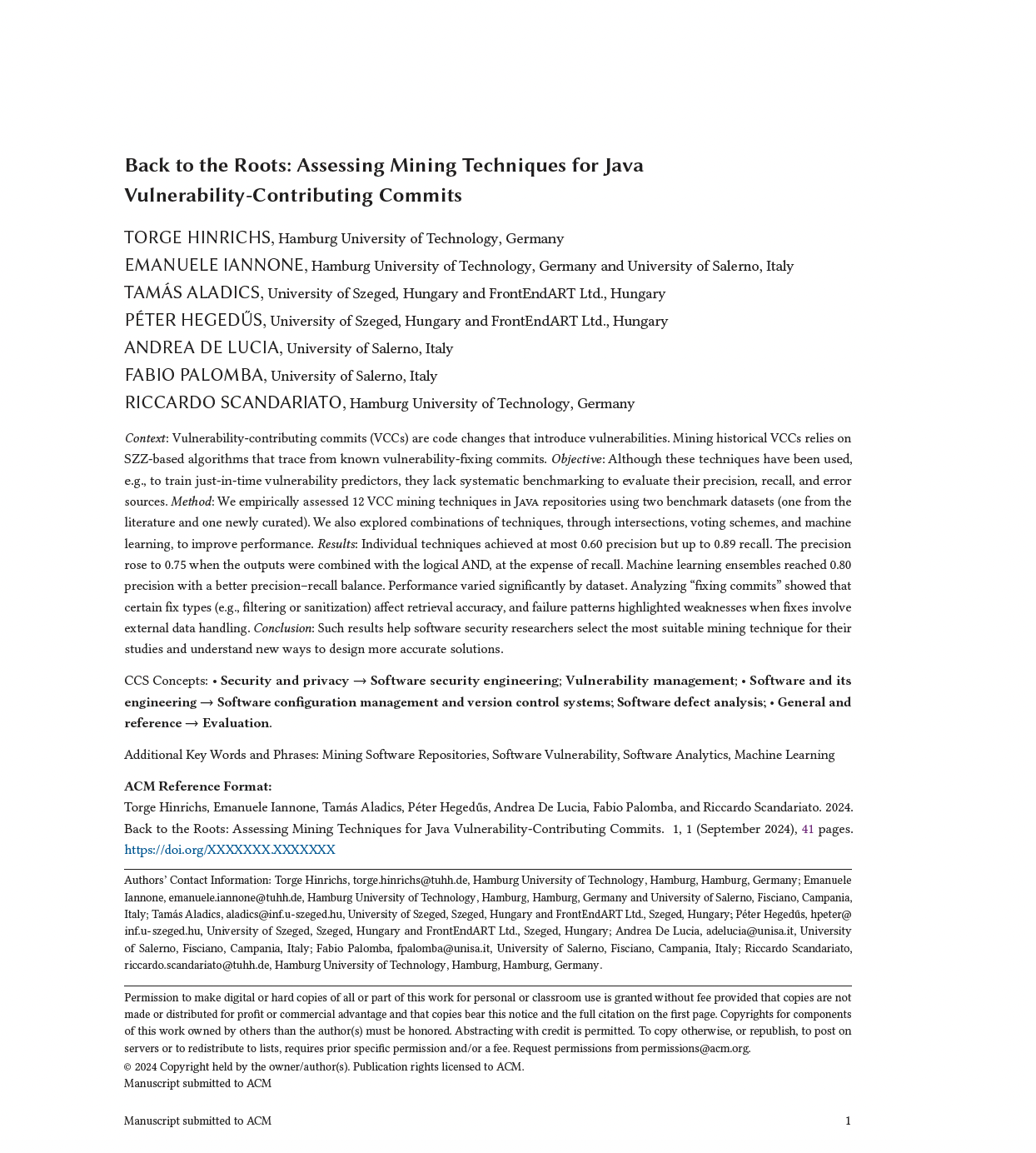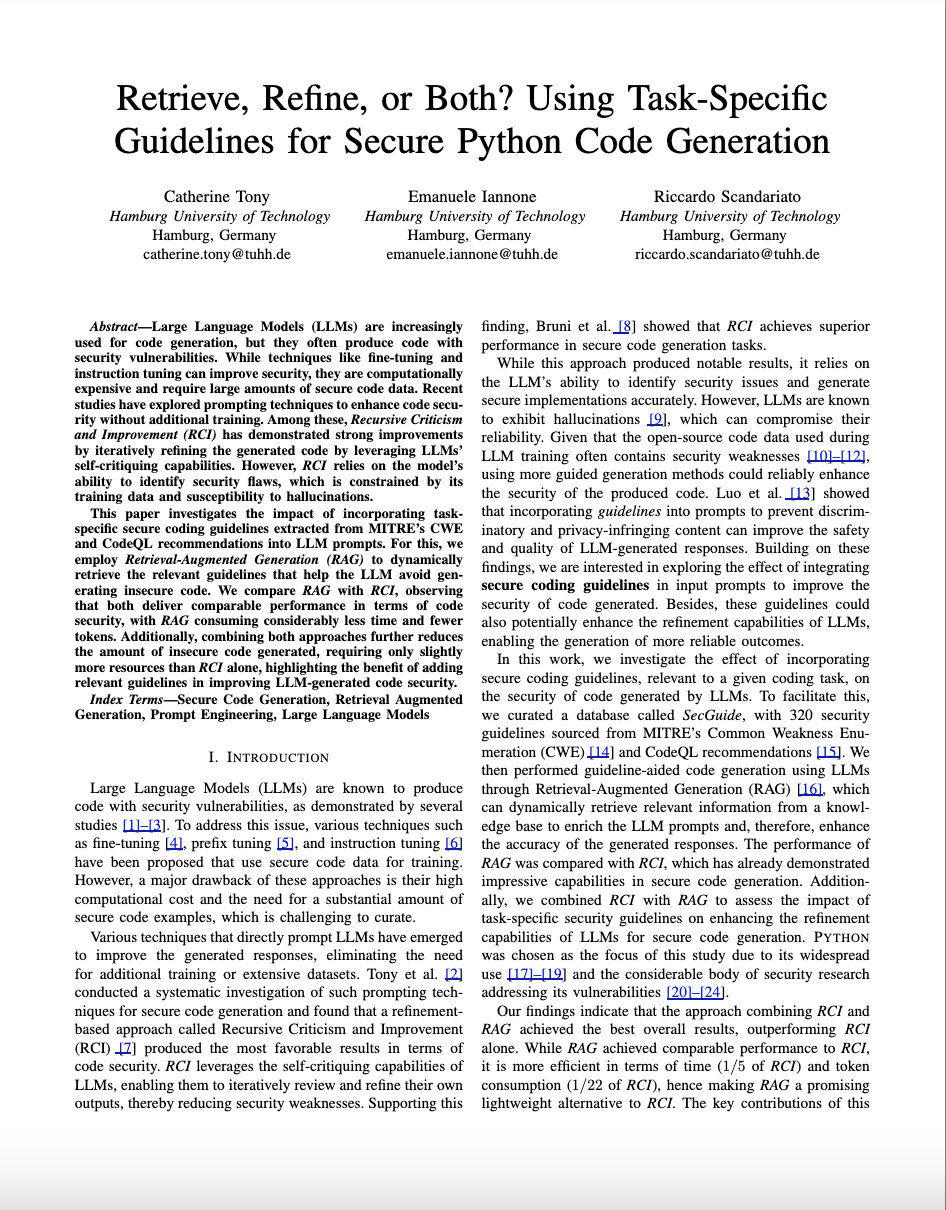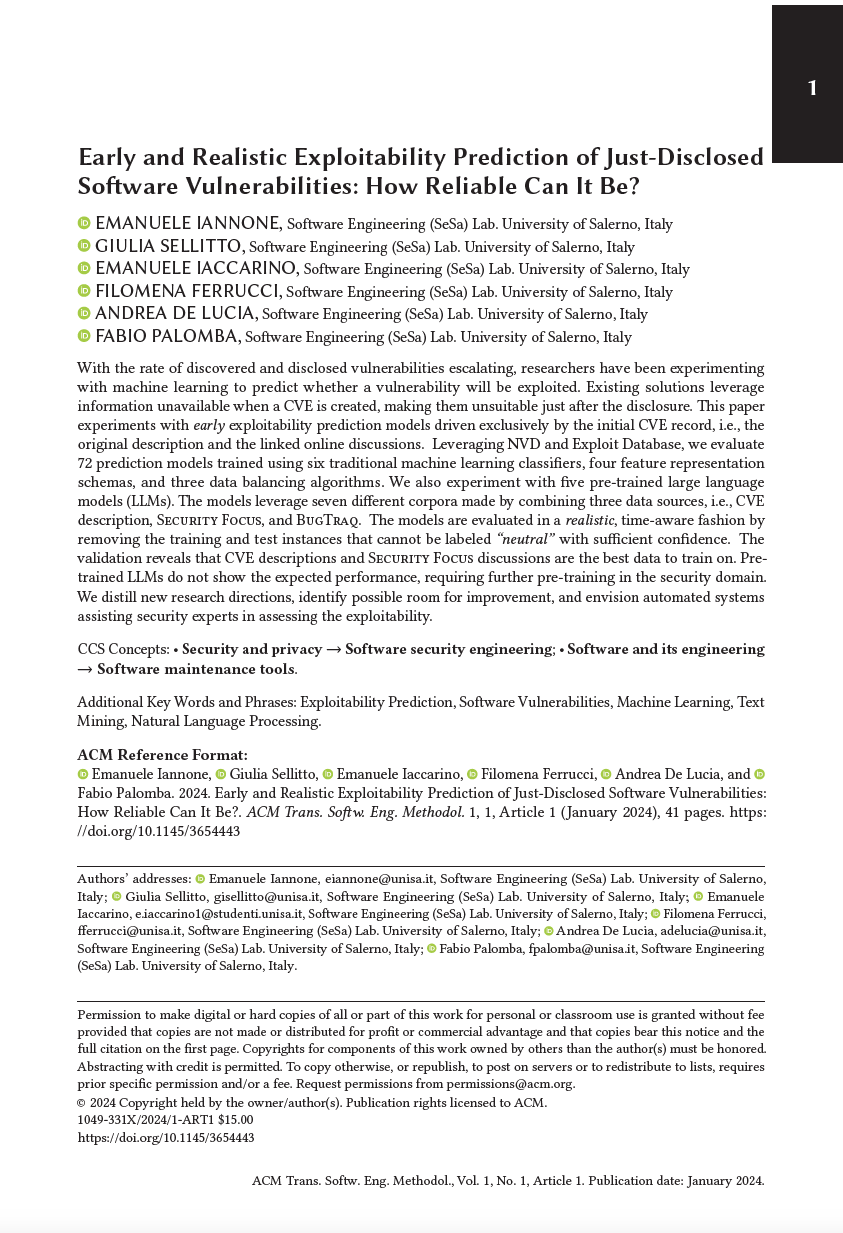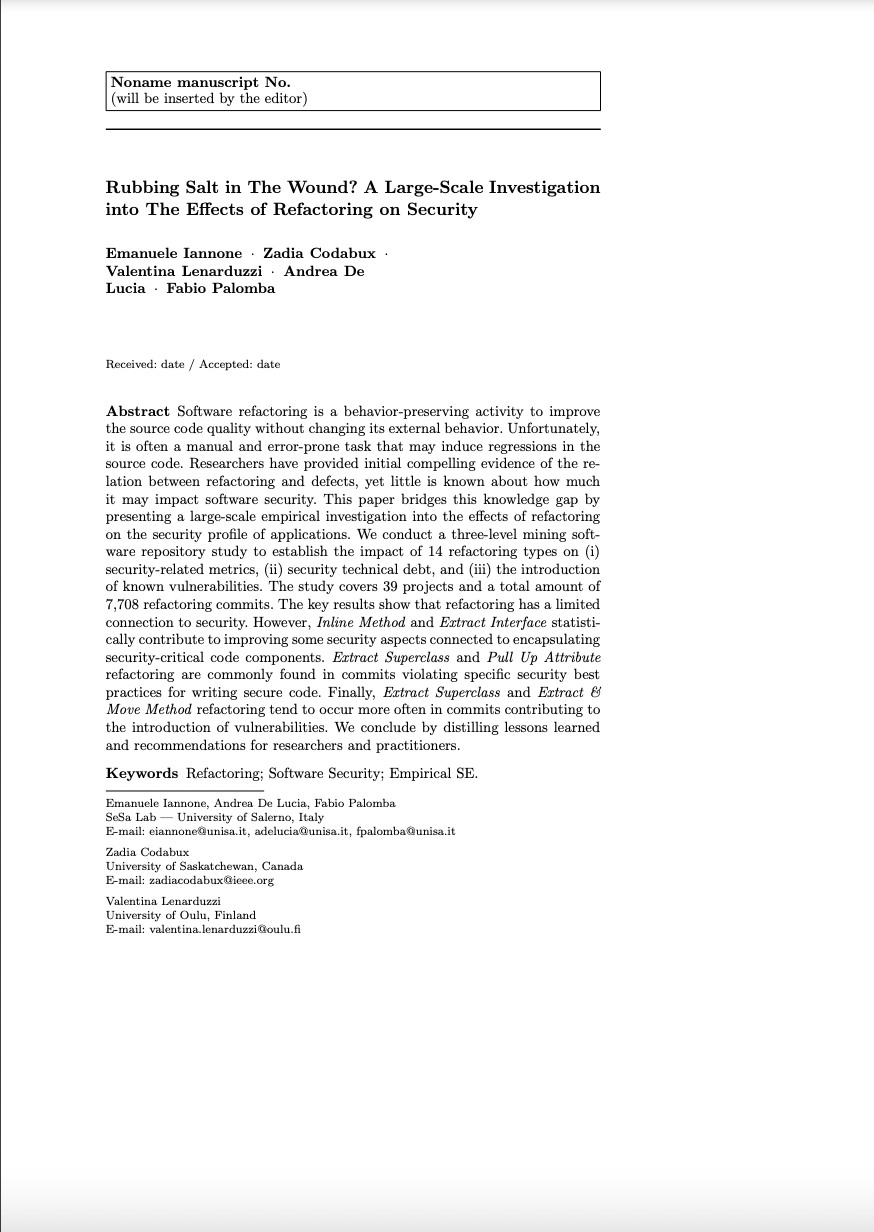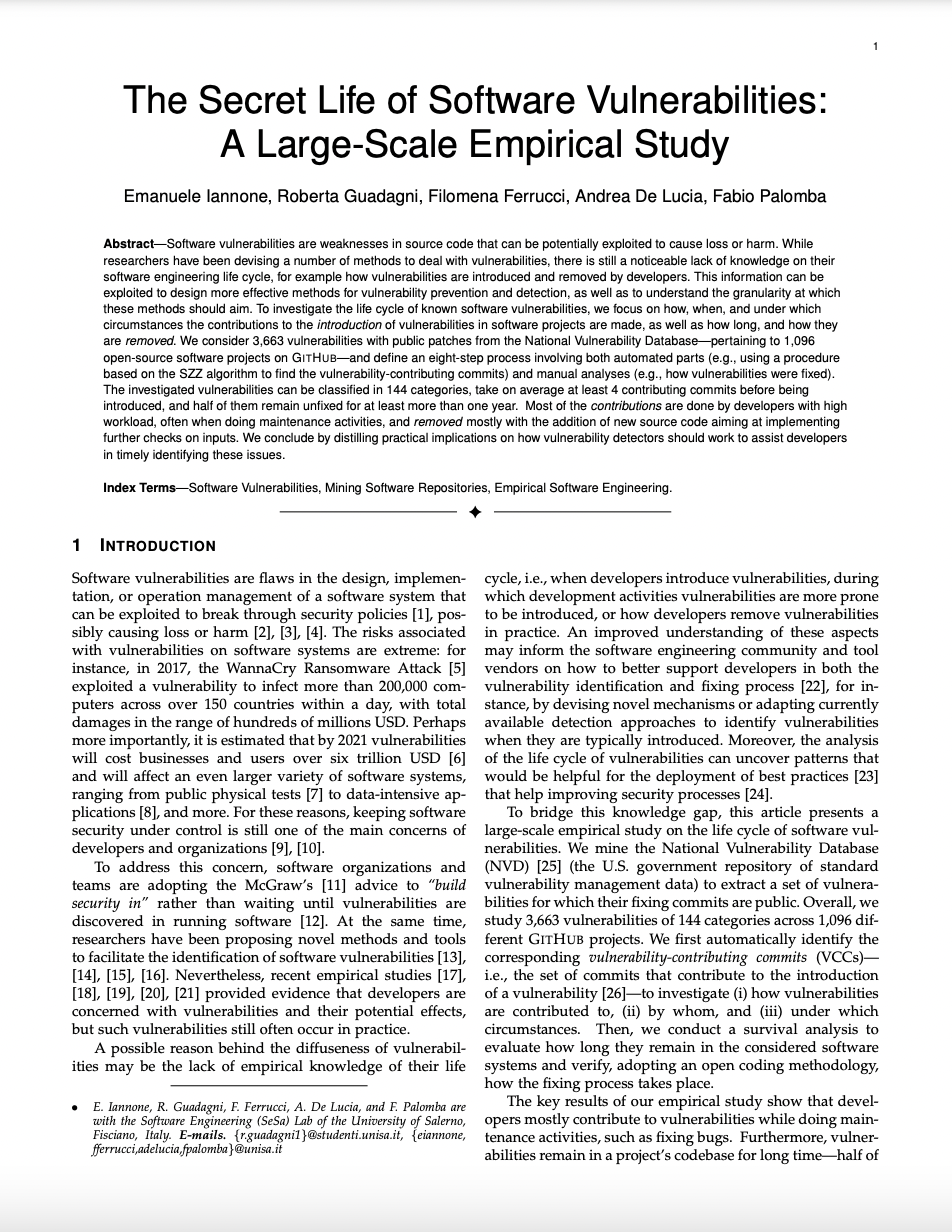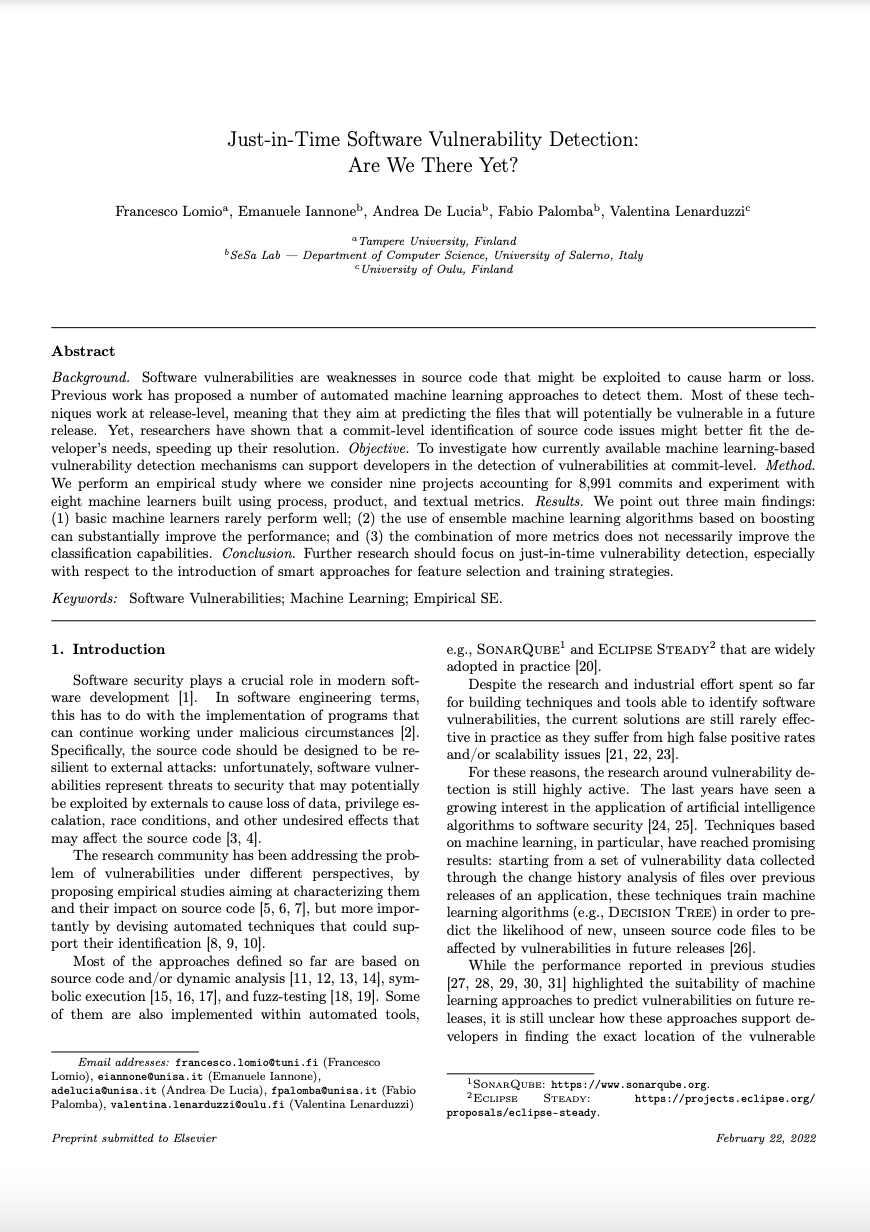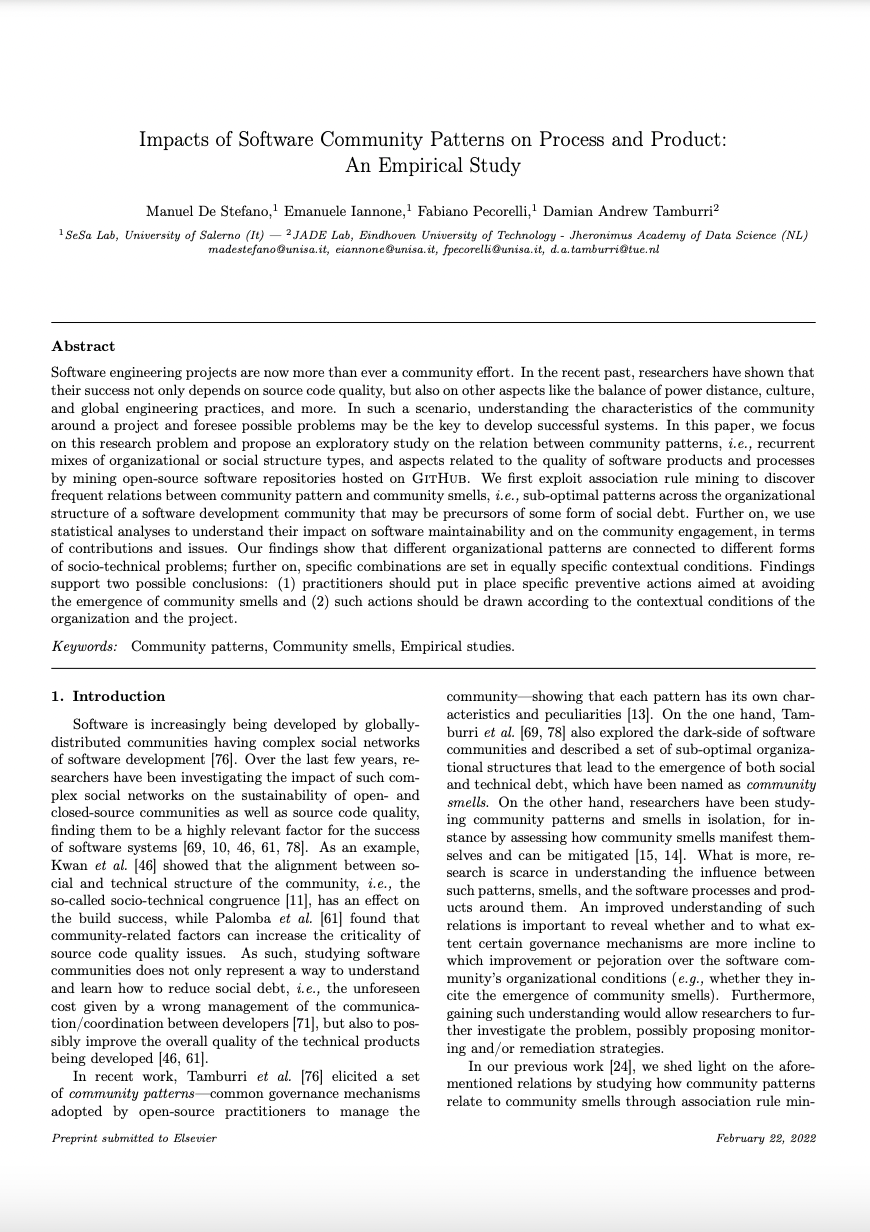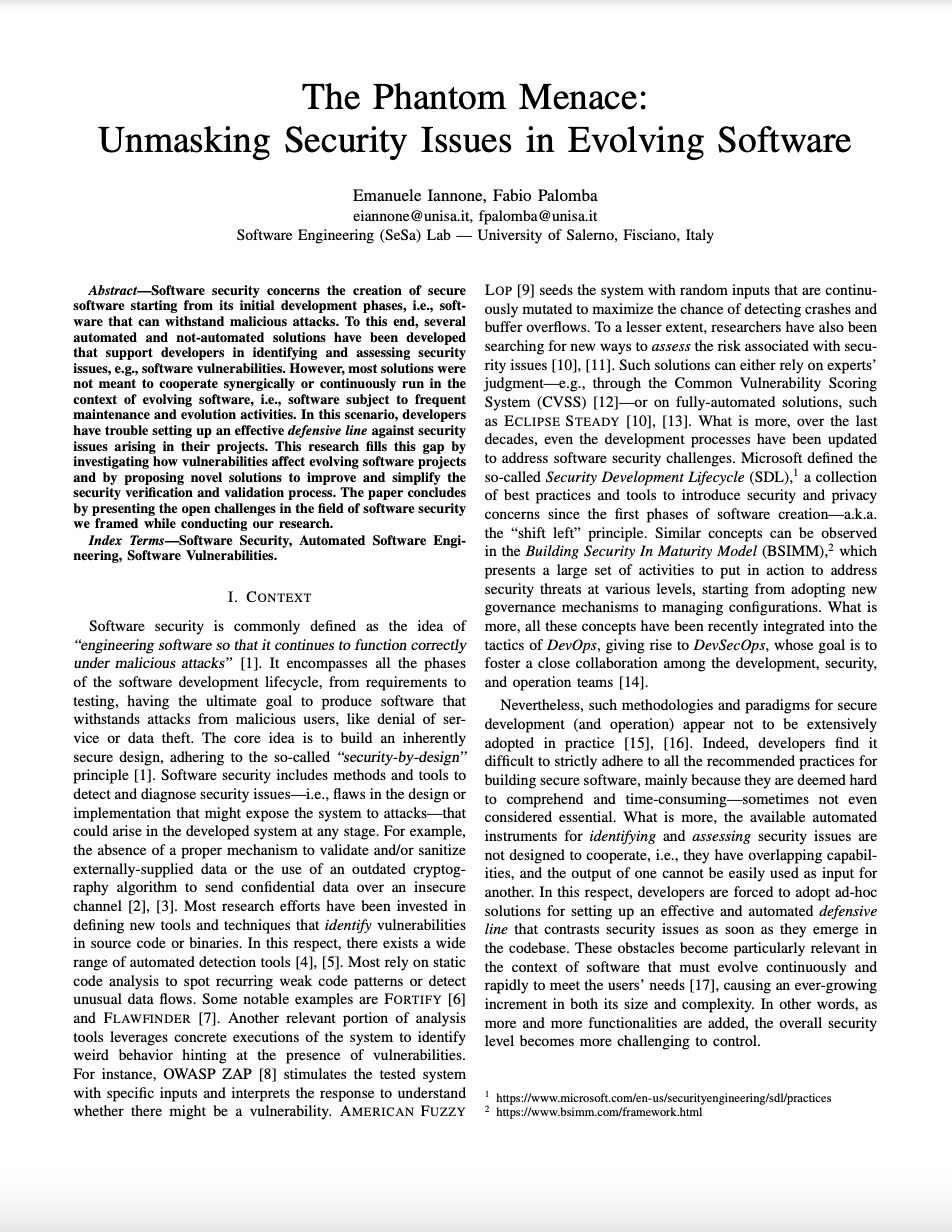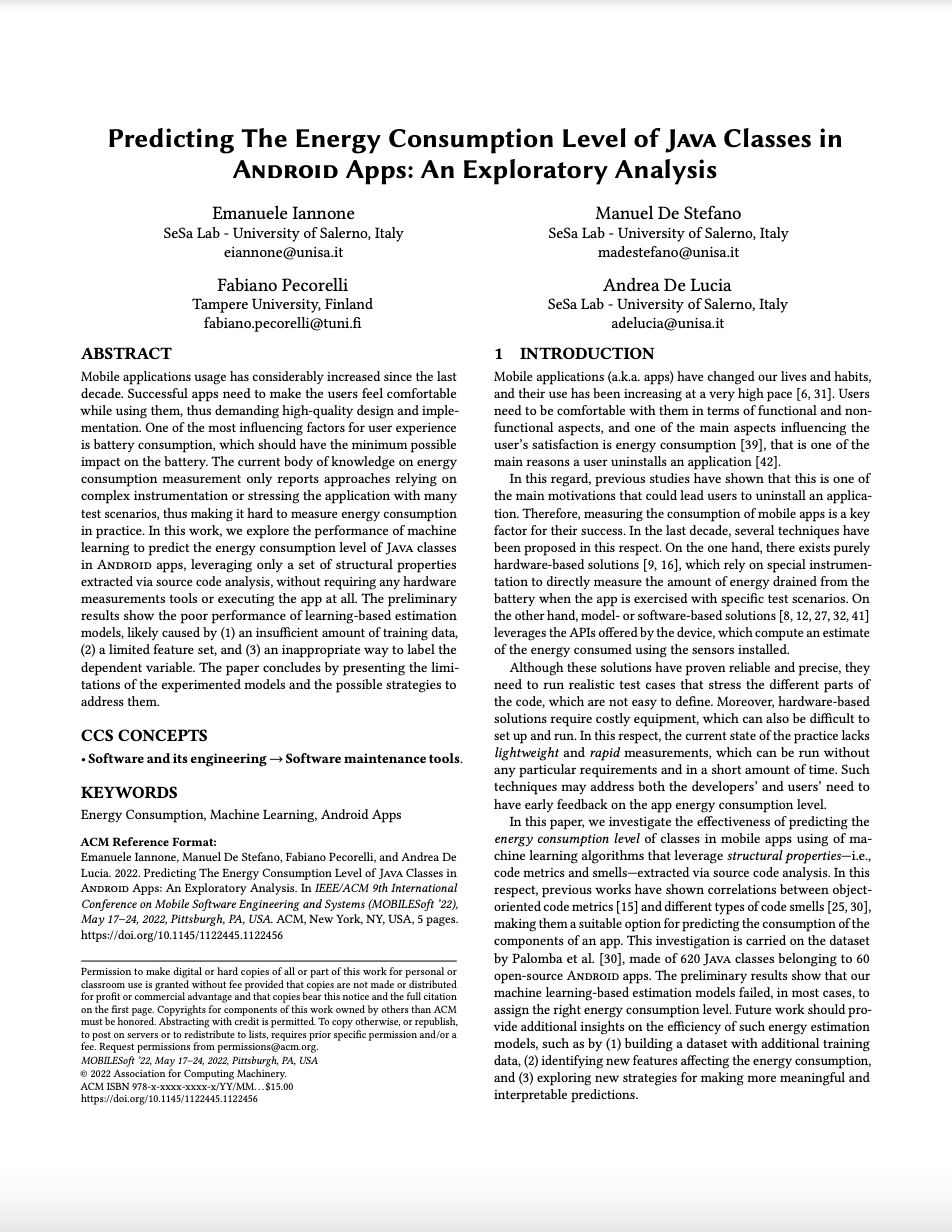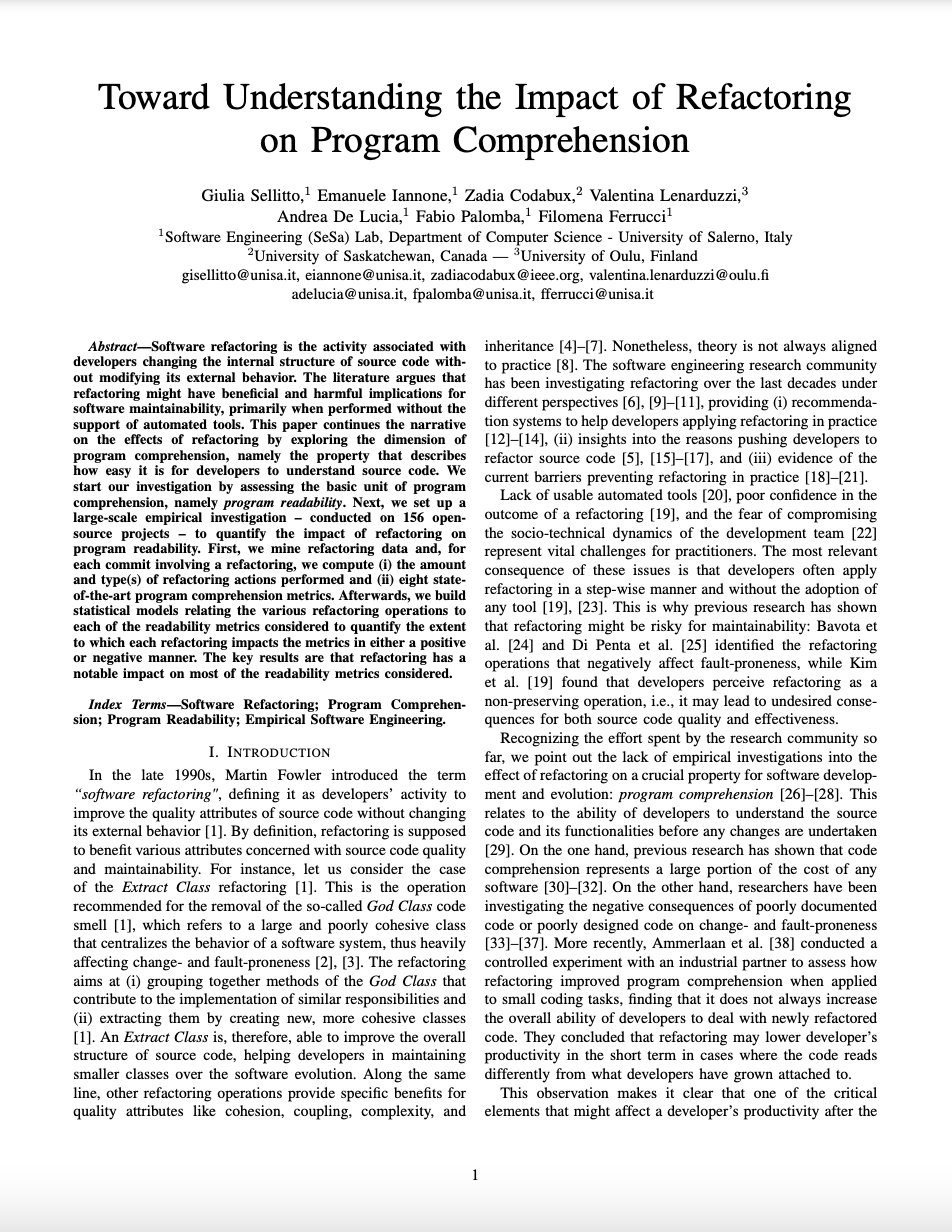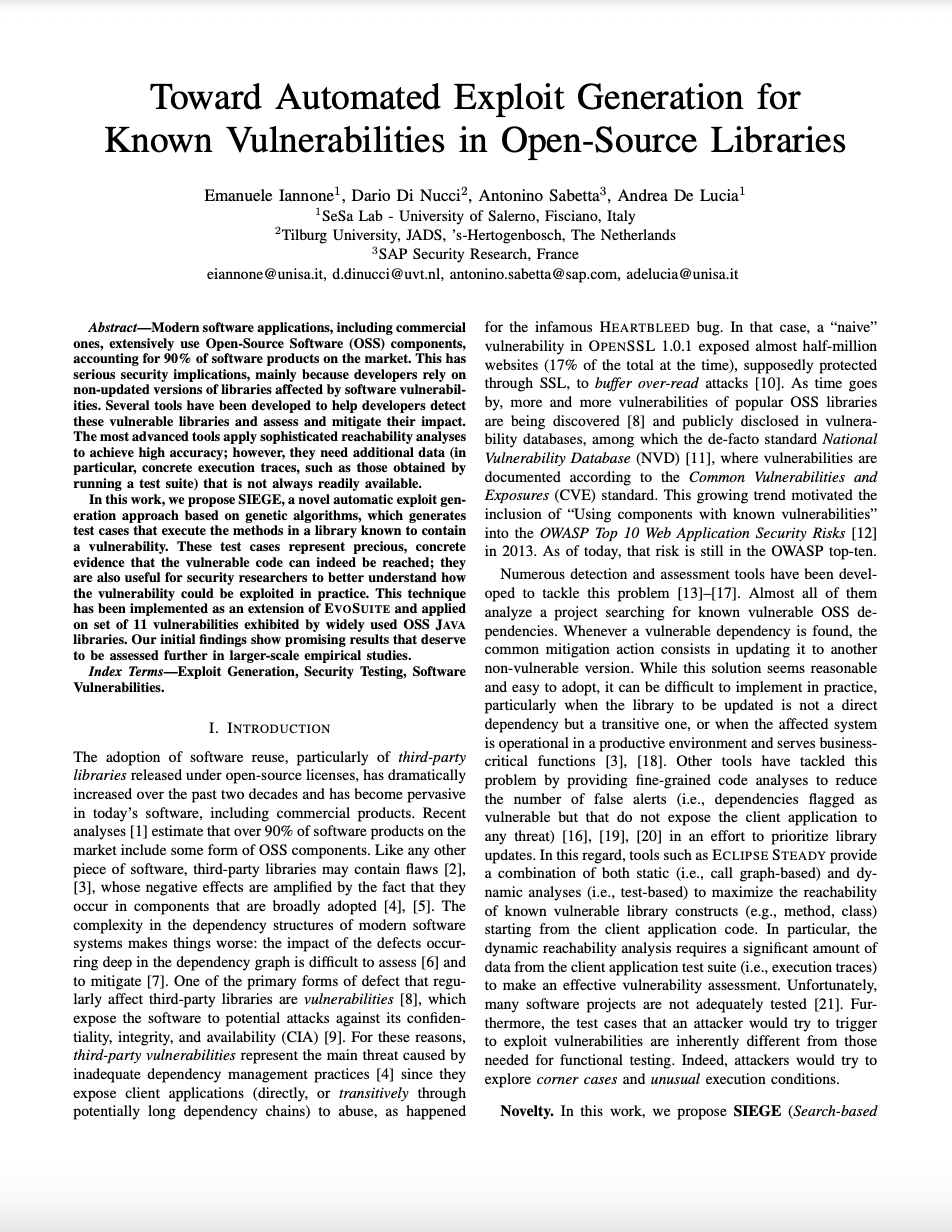Publications
The complete list of my publications sorted in reversed chronological order.
2025
- CySe
 Beyond Prompting: The Role of Phrasing Tasks in Vulnerability Prediction for JavaTorge Hinrichs, Emanuele Iannone, and Riccardo ScandariatoCybersecurity, Dec 2025
Beyond Prompting: The Role of Phrasing Tasks in Vulnerability Prediction for JavaTorge Hinrichs, Emanuele Iannone, and Riccardo ScandariatoCybersecurity, Dec 2025Predicting vulnerability in a code element, such as a function or method, often leverages machine or deep learning models to classify whether it is vulnerable or not. Recently, novel solutions exploiting conversational large language models (LLMs) have emerged, which allow the formulation of the task through a prompt containing natural language elements and the input code element, obtaining a natural language as a response. Although initial promising results, there is currently no broad exploration of (i) how the input prompt influences the prediction capabilities and (ii) what characteristics of the model response relate to correct predictions. In this paper, we conduct an empirical investigation into how accurately two popular conversational LLMs, i.e., GPT-3.5 and Llama-2, predict whether a Java method is vulnerable by employing a thorough prompting strategy by (i) adhering to the Zero-Shot and Zero-Shot Chain-of-Thought techniques and (ii) formulating the prediction task in alternative ways via rephrasing. After a manual inspection of the responses generated, we observed that GPT-3.5 displayed more variable F1 scores compared to Llama-2, which was steadier but often gave no direct classification. ZS prompts achieved F1 scores between 0.53 and 0.69, with a tendency of classifying methods positively (i.e., ‘vulnerable’); conversely, ZS-CoT presents a broader range of scores, varying from 0.35 to 0.72, with often inconsistencies in the results. Then, we phrased the task in their “inverted form”, i.e., asking the LLM to check for the absence of vulnerabilities, which led to worse results for GPT-3.5, while Llama-2 occasionally performed better. The study further suggests that textual metrics provide important information on LLM outputs. Despite this, these metrics are not correlated with actual outcomes, as the models respond consistently with uniform confidence, irrespective of whether the outcome is correct or not. This underscores the need for customized prompt engineering and response analysis strategies to improve the precision and reliability of LLM-based systems for vulnerability prediction. In addition, we applied our study to two state-of-the-art LLMs, validating the broader applicability of our methodology. Finally, we performed an analysis of various textual properties of the model responses, such as response length and readability scores, to further explore the characteristics of the responses given for vulnerability detection tasks.
@article{hinrichs:cyse2025:prompting:vuln, author = {Hinrichs, Torge and Iannone, Emanuele and Scandariato, Riccardo}, title = {Beyond Prompting: The Role of Phrasing Tasks in Vulnerability Prediction for Java}, journal = {Cybersecurity}, year = {2025}, month = dec, day = {08}, volume = {8}, number = {1}, pages = {111}, issn = {2523-3246}, doi = {10.1186/s42400-025-00476-0}, url = {https://link.springer.com/article/10.1186/s42400-025-00476-0} } - Back to the Roots: Assessing Mining Techniques for Java Vulnerability-Contributing CommitsTorge Hinrichs, Emanuele Iannone, Tamás Aladics, Péter Hegedűs, Andrea De Lucia, Fabio Palomba, and Riccardo ScandariatoACM Trans. Softw. Eng. Methodol., Sep 2025
Context: Vulnerability-contributing commits (VCCs) are code changes that introduce vulnerabilities. Mining historical VCCs relies on SZZ-based algorithms that trace from known vulnerability-fixing commits. Objective: Although these techniques have been used, e.g., to train just-in-time vulnerability predictors, they lack systematic benchmarking to evaluate their precision, recall, and error sources. Method: We empirically assessed 12 VCC mining techniques in Java repositories using two benchmark datasets (one from the literature and one newly curated). We also explored combinations of techniques, through intersections, voting schemes, and machine learning, to improve performance. Results: Individual techniques achieved at most 0.60 precision but up to 0.89 recall. The precision rose to 0.75 when the outputs were combined with the logical AND, at the expense of recall. Machine learning ensembles reached 0.80 precision with a better precision–recall balance. Performance varied significantly by dataset. Analyzing “fixing commits” showed that certain fix types (e.g., filtering or sanitization) affect retrieval accuracy, and failure patterns highlighted weaknesses when fixes involve external data handling. Conclusion: Such results help software security researchers select the most suitable mining technique for their studies and understand new ways to design more accurate solutions.
@article{hinrichs:tosem2025:szz:vcc, author = {Hinrichs, Torge and Iannone, Emanuele and Aladics, Tam\'{a}s and Hegedűs, P\'{e}ter and De Lucia, Andrea and Palomba, Fabio and Scandariato, Riccardo}, title = {Back to the Roots: Assessing Mining Techniques for Java Vulnerability-Contributing Commits}, year = {2025}, publisher = {Association for Computing Machinery}, address = {New York, NY, USA}, issn = {1049-331X}, url = {https://dl.acm.org/doi/10.1145/3769105}, doi = {10.1145/3769105}, journal = {ACM Trans. Softw. Eng. Methodol.}, month = sep, keywords = {Mining Software Repositories, Software Vulnerability, Software Analytics, Machine Learning} } - SEAA
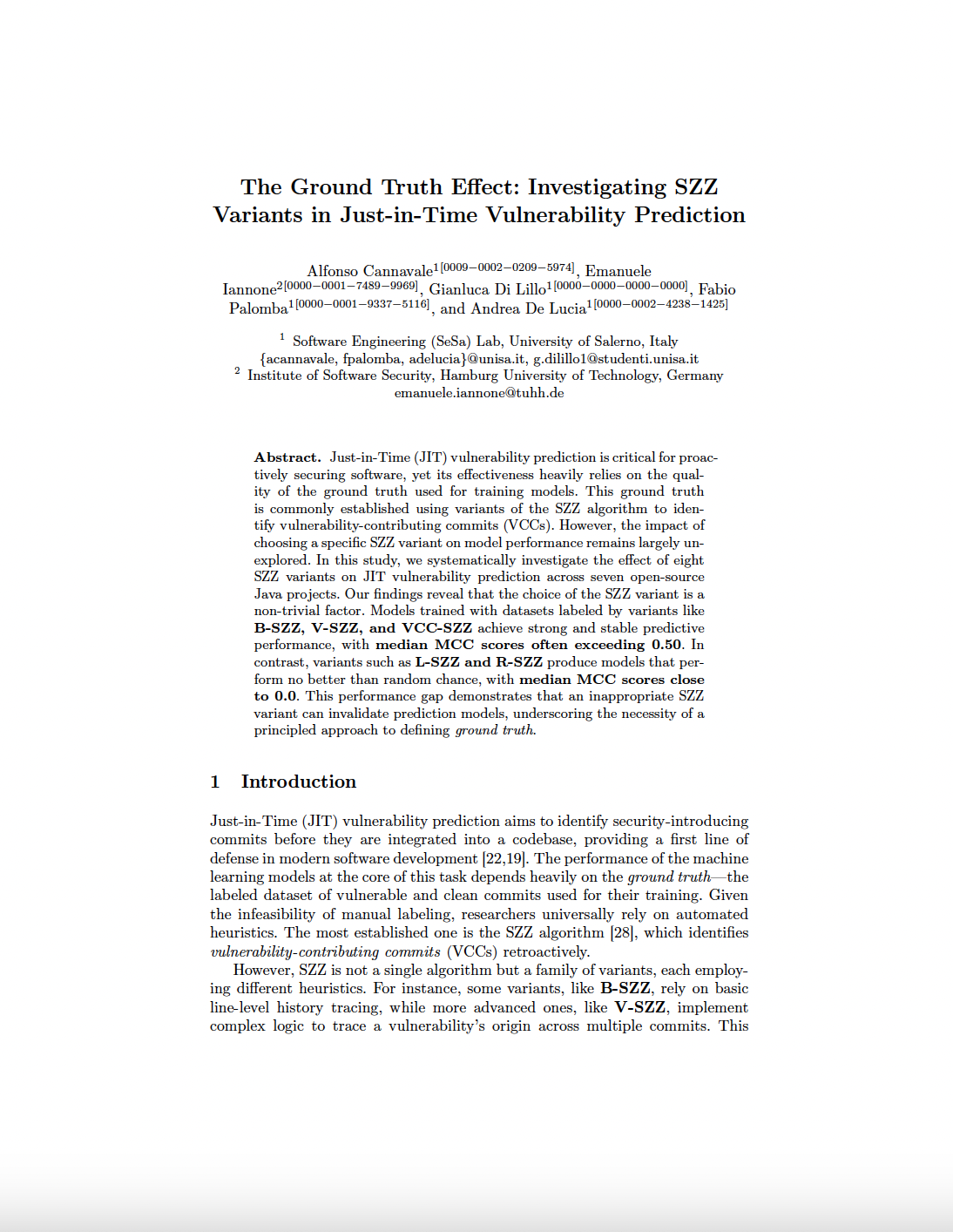 The Ground Truth Effect: Investigating SZZ Variants in Just-in-Time Vulnerability PredictionIn Software Engineering and Advanced Applications, Sep 2025
The Ground Truth Effect: Investigating SZZ Variants in Just-in-Time Vulnerability PredictionIn Software Engineering and Advanced Applications, Sep 2025Just-in-Time (JIT) vulnerability prediction is critical for proactively securing software, yet its effectiveness heavily relies on the quality of the ground truth used for training models. This ground truth is commonly established using variants of the SZZ algorithm to identify vulnerability-contributing commits (VCCs). However, the impact of choosing a specific SZZ variant on model performance remains largely unexplored. In this study, we systematically investigate the effect of eight SZZ variants on JIT vulnerability prediction across seven open-source Java projects. Our findings reveal that the choice of the SZZ variant is a non-trivial factor. Models trained with datasets labeled by variants like B-SZZ, V-SZZ, and VCC-SZZ achieve strong and stable predictive performance, with median MCC scores often exceeding 0.50. In contrast, variants such as L-SZZ and R-SZZ produce models that perform no better than random chance, with median MCC scores close to 0.0. This performance gap demonstrates that an inappropriate SZZ variant can invalidate prediction models, underscoring the necessity of a principled approach to defining ground truth.
@inproceedings{cannavale:seaa2025:szz:vuln, author = {Cannavale, Alfonso and Iannone, Emanuele and {Di Lillo}, Gianluca and Palomba, Fabio and {De Lucia}, Andrea}, editor = {Taibi, Davide and Smite, Darja}, title = {The Ground Truth Effect: Investigating SZZ Variants in Just-in-Time Vulnerability Prediction}, booktitle = {Software Engineering and Advanced Applications}, year = {2025}, month = sep, publisher = {Springer Nature Switzerland}, address = {Cham}, pages = {317--326}, isbn = {978-3-032-04207-1}, url = {https://link.springer.com/chapter/10.1007/978-3-032-04207-1_21}, doi = {10.1007/978-3-032-04207-1_21} } - Retrieve, Refine, or Both? Using Task-Specific Guidelines for Secure Python Code GenerationCatherine Tony, Emanuele Iannone, and Riccardo ScandariatoIn 2025 IEEE International Conference on Software Maintenance and Evolution (ICSME), Sep 2025
Large Language Models (LLMs) are increasingly used for code generation, but they often produce code with security vulnerabilities. While techniques like fine-tuning and instruction tuning can improve security, they are computationally expensive and require large amounts of secure code data. Recent studies have explored prompting techniques to enhance code security without additional training. Among these, Recursive Criticism and Improvement (RCI) has demonstrated strong improvements by iteratively refining the generated code by leveraging LLMs’ self-critiquing capabilities. However, RCI relies on the model’s ability to identify security flaws, which is constrained by its training data and susceptibility to hallucinations. This paper investigates the impact of incorporating task-specific secure coding guidelines extracted from MITRE’s CWE and CodeQL recommendations into LLM prompts. For this, we employ Retrieval-Augmented Generation (RAG) to dynamically retrieve the relevant guidelines that help the LLM avoid generating insecure code. We compare RAG with RCI, observing that both deliver comparable performance in terms of code security, with RAG consuming considerably less time and fewer tokens. Additionally, combining both approaches further reduces the amount of insecure code generated, requiring only slightly more resources than RCI alone, highlighting the benefit of adding relevant guidelines in improving LLM-generated code security.
author = {Tony, Catherine and Iannone, Emanuele and Scandariato, Riccardo}, booktitle = {2025 IEEE International Conference on Software Maintenance and Evolution (ICSME)}, title = {Retrieve, Refine, or Both? Using Task-Specific Guidelines for Secure Python Code Generation}, year = {2025}, volume = {}, number = {}, pages = {368-379}, keywords = {Training;Codes;Large language models;Retrieval augmented generation;Training data;Encoding;Security;Tuning;Guidelines;Python;Secure Code Generation;Retrieval Augmented Generation;Prompt Engineering;Large Language Models}, doi = {10.1109/ICSME64153.2025.00041}, url = {https://ieeexplore.ieee.org/document/11186069}, issn = {2576-3148}, month = sep } - arXiv
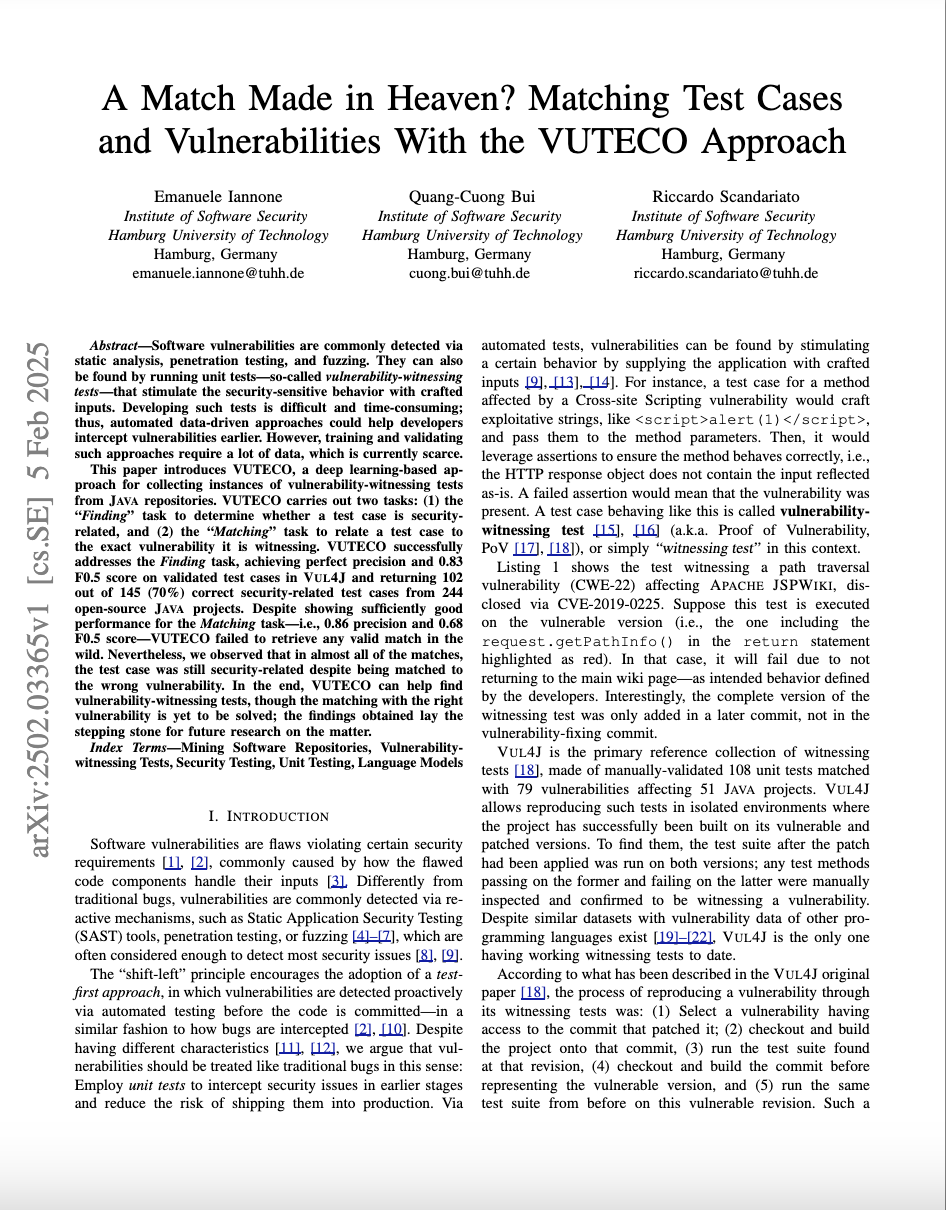 A Match Made in Heaven? Matching Test Cases and Vulnerabilities With the VUTECO ApproachEmanuele Iannone, Quang-Cuong Bui, and Riccardo ScandariatoarXiv, Feb 2025
A Match Made in Heaven? Matching Test Cases and Vulnerabilities With the VUTECO ApproachEmanuele Iannone, Quang-Cuong Bui, and Riccardo ScandariatoarXiv, Feb 2025title = {A Match Made in Heaven? Matching Test Cases and Vulnerabilities With the VUTECO Approach}, author = {Iannone, Emanuele and Bui, Quang-Cuong and Scandariato, Riccardo}, month = feb, year = {2025}, eprint = {2502.03365}, archiveprefix = {arXiv}, primaryclass = {cs.SE}, } - arXiv
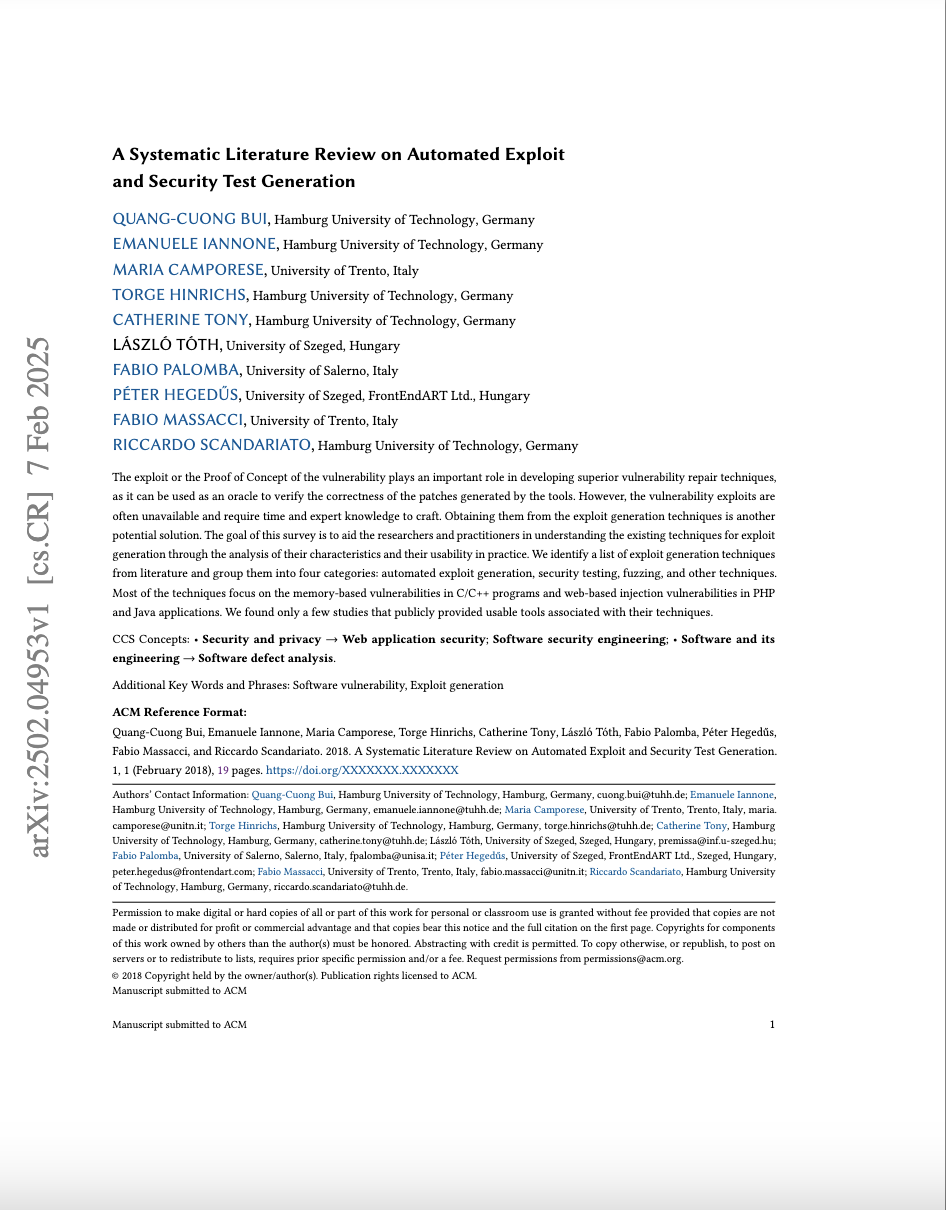 A Systematic Literature Review on Automated Exploit and Security Test GenerationQuang-Cuong Bui, Emanuele Iannone, Maria Camporese, Torge Hinrichs, Catherine Tony, László Tóth, Fabio Palomba, Péter Hegedűs, Fabio Massacci, and Riccardo ScandariatoarXiv, Feb 2025
A Systematic Literature Review on Automated Exploit and Security Test GenerationQuang-Cuong Bui, Emanuele Iannone, Maria Camporese, Torge Hinrichs, Catherine Tony, László Tóth, Fabio Palomba, Péter Hegedűs, Fabio Massacci, and Riccardo ScandariatoarXiv, Feb 2025title = {A Systematic Literature Review on Automated Exploit and Security Test Generation}, author = {Bui, Quang-Cuong and Iannone, Emanuele and Camporese, Maria and Hinrichs, Torge and Tony, Catherine and Tóth, László and Palomba, Fabio and Hegedűs, Péter and Massacci, Fabio and Scandariato, Riccardo}, month = feb, year = {2025}, eprint = {2502.04953}, archiveprefix = {arXiv}, primaryclass = {cs.CR}, }
2024
- Early and Realistic Exploitability Prediction of Just-Disclosed Software Vulnerabilities: How Reliable Can It Be?Emanuele Iannone, Giulia Sellitto, Emanuele Iaccarino, Filomena Ferrucci, Andrea De Lucia, and Fabio PalombaACM Transactions on Software Engineering and Methodology, Mar 2024
With the rate of discovered and disclosed vulnerabilities escalating, researchers have been experimenting with machine learning to predict whether a vulnerability will be exploited. Existing solutions leverage information unavailable when a CVE is created, making them unsuitable just after the disclosure. This paper experiments with early exploitability prediction models driven exclusively by the initial CVE record, i.e., the original description and the linked online discussions. Leveraging NVD and Exploit Database, we evaluate 72 prediction models trained using six traditional machine learning classifiers, four feature representation schemas, and three data balancing algorithms. We also experiment with five pre-trained large language models (LLMs). The models leverage seven different corpora made by combining three data sources, i.e., CVE description, Security Focus, and BugTraq. The models are evaluated in a realistic, time-aware fashion by removing the training and test instances that cannot be labeled “neutral” with sufficient confidence. The validation reveals that CVE descriptions and Security Focus discussions are the best data to train on. Pre-trained LLMs do not show the expected performance, requiring further pre-training in the security domain. We distill new research directions, identify possible room for improvement, and envision automated systems assisting security experts in assessing the exploitability.
@article{iannone:tosem2024:exploitability:prediction, author = {Iannone, Emanuele and Sellitto, Giulia and Iaccarino, Emanuele and Ferrucci, Filomena and De Lucia, Andrea and Palomba, Fabio}, title = {Early and Realistic Exploitability Prediction of Just-Disclosed Software Vulnerabilities: How Reliable Can It Be?}, year = {2024}, publisher = {Association for Computing Machinery}, address = {New York, NY, USA}, issn = {1049-331X}, url = {https://dl.acm.org/doi/10.1145/3654443}, doi = {10.1145/3654443}, journal = {ACM Transactions on Software Engineering and Methodology}, month = mar, keywords = {Exploitability Prediction, Software Vulnerabilities, Machine Learning, Text Mining, Natural Language Processing.} }
2023
- Rubbing salt in the wound? A large-scale investigation into the effects of refactoring on securityEmpirical Software Engineering, May 2023
Software refactoring is a behavior-preserving activity to improve the source code quality without changing its external behavior. Unfortunately, it is often a manual and error-prone task that may induce regressions in the source code. Researchers have provided initial compelling evidence of the relation between refactoring and defects, yet little is known about how much it may impact software security. This paper bridges this knowledge gap by presenting a large-scale empirical investigation into the effects of refactoring on the security profile of applications. We conduct a three-level mining software repository study to establish the impact of 14 refactoring types on (i) security-related metrics, (ii) security technical debt, and (iii) the introduction of known vulnerabilities. The study covers 39 projects and a total amount of 7,708 refactoring commits. The key results show that refactoring has a limited connection to security. However, Inline Method and Extract Interface statistically contribute to improving some security aspects connected to encapsulating security-critical code components. Extract Superclass and Pull Up Attribute refactoring are commonly found in commits violating specific security best practices for writing secure code. Finally, Extract Superclass and Extract & Move Method refactoring tend to occur more often in commits contributing to the introduction of vulnerabilities. We conclude by distilling lessons learned and recommendations for researchers and practitioners.
@article{iannone:emse2023:refactoring:security, author = {Iannone, Emanuele and Codabux, Zadia and Lenarduzzi, Valentina and De Lucia, Andrea and Palomba, Fabio}, title = {Rubbing salt in the wound? A large-scale investigation into the effects of refactoring on security}, journal = {Empirical Software Engineering}, year = {2023}, month = may, day = {24}, volume = {28}, number = {4}, pages = {89}, issn = {1573-7616}, doi = {10.1007/s10664-023-10287-x}, url = {https://link.springer.com/article/10.1007/s10664-023-10287-x} } - The Secret Life of Software Vulnerabilities: A Large-Scale Empirical StudyIEEE Transactions on Software Engineering, Jan 2023
Software vulnerabilities are weaknesses in source code that can be potentially exploited to cause loss or harm. While researchers have been devising a number of methods to deal with vulnerabilities, there is still a noticeable lack of knowledge on their software engineering life cycle, for example how vulnerabilities are introduced and removed by developers. This information can be exploited to design more effective methods for vulnerability prevention and detection, as well as to understand the granularity at which these methods should aim. To investigate the life cycle of known software vulnerabilities, we focus on how, when, and under which circumstances the contributions to the introduction of vulnerabilities in software projects are made, as well as how long, and how they are removed. We consider 3,663 vulnerabilities with public patches from the National Vulnerability Database—pertaining to 1,096 open-source software projects on GitHub—and define an eight-step process involving both automated parts (e.g., using a procedure based on the SZZ algorithm to find the vulnerability-contributing commits) and manual analyses (e.g., how vulnerabilities were fixed). The investigated vulnerabilities can be classified in 144 categories, take on average at least 4 contributing commits before being introduced, and half of them remain unfixed for at least more than one year. Most of the contributions are done by developers with high workload, often when doing maintenance activities, and removed mostly with the addition of new source code aiming at implementing further checks on inputs. We conclude by distilling practical implications on how vulnerability detectors should work to assist developers in timely identifying these issues.
@article{iannone:tse2022:secret:life, author = {Iannone, Emanuele and Guadagni, Roberta and Ferrucci, Filomena and De Lucia, Andrea and Palomba, Fabio}, journal = {IEEE Transactions on Software Engineering}, title = {The Secret Life of Software Vulnerabilities: A Large-Scale Empirical Study}, year = {2023}, volume = {49}, number = {1}, pages = {44-63}, keywords = {}, doi = {10.1109/TSE.2022.3140868}, url = {https://ieeexplore.ieee.org/document/9672730}, issn = {1939-3520}, month = jan }
2022
- Just-in-time software vulnerability detection: Are we there yet?Journal of Systems and Software, Jun 2022
Background: Software vulnerabilities are weaknesses in source code that might be exploited to cause harm or loss. Previous work has proposed a number of automated machine learning approaches to detect them. Most of these techniques work at release-level, meaning that they aim at predicting the files that will potentially be vulnerable in a future release. Yet, researchers have shown that a commit-level identification of source code issues might better fit the developer’s needs, speeding up their resolution. Objective: To investigate how currently available machine learning-based vulnerability detection mechanisms can support developers in the detection of vulnerabilities at commit-level. Method: We perform an empirical study where we consider nine projects accounting for 8991 commits and experiment with eight machine learners built using process, product, and textual metrics. Results: We point out three main findings: (1) basic machine learners rarely perform well; (2) the use of ensemble machine learning algorithms based on boosting can substantially improve the performance; and (3) the combination of more metrics does not necessarily improve the classification capabilities. Conclusion: Further research should focus on just-in-time vulnerability detection, especially with respect to the introduction of smart approaches for feature selection and training strategies.
@article{lomio:jss2022:jit:vulnerability:prediction, title = {Just-in-time software vulnerability detection: Are we there yet?}, journal = {Journal of Systems and Software}, volume = {188}, pages = {111283}, year = {2022}, month = jun, issn = {0164-1212}, doi = {10.1016/j.jss.2022.111283}, url = {https://www.sciencedirect.com/science/article/pii/S0164121222000437}, author = {Lomio, Francesco and Iannone, Emanuele and {De Lucia}, Andrea and Palomba, Fabio and Lenarduzzi, Valentina}, keywords = {Software vulnerabilities, Machine learning, Empirical SE} } - Impacts of software community patterns on process and product: An empirical studyScience of Computer Programming, Feb 2022
Software engineering projects are now more than ever a community effort. In the recent past, researchers have shown that their success not only depends on source code quality, but also on other aspects like the balance of power distance, culture, and global engineering practices, and more. In such a scenario, understanding the characteristics of the community around a project and foresee possible problems may be the key to develop successful systems. In this paper, we focus on this research problem and propose an exploratory study on the relation between community patterns, i.e.,recurrent mixes of organizational or social structure types, and aspects related to the quality of software products and processes by mining open-source software repositories hosted on GitHub. We first exploit association rule mining to discover frequent relations between community pattern and community smells, i.e.,sub-optimal patterns across the organizational structure of a software development community that may be precursors of some form of social debt. Further on, we use statistical analyses to understand their impact on software maintainability and on the community engagement, in terms of contributions and issues. Our findings show that different organizational patterns are connected to different forms of socio-technical problems; further on, specific combinations are set in equally specific contextual conditions. Findings support two possible conclusions: (1) practitioners should put in place specific preventive actions aimed at avoiding the emergence of community smells and (2) such actions should be drawn according to the contextual conditions of the organization and the project.
@article{destefano:scico2020:impact:comunity, title = {Impacts of software community patterns on process and product: An empirical study}, journal = {Science of Computer Programming}, volume = {214}, pages = {102731}, year = {2022}, month = feb, issn = {0167-6423}, doi = {10.1016/j.scico.2021.102731}, url = {https://www.sciencedirect.com/science/article/pii/S0167642321001246}, author = {{De Stefano}, Manuel and Iannone, Emanuele and Pecorelli, Fabiano and Tamburri, Damian Andrew}, keywords = {Community patterns, Community smells, Empirical studies} } - The Phantom Menace: Unmasking Security Issues in Evolving SoftwareEmanuele Iannone, and Fabio PalombaIn 2022 IEEE International Conference on Software Maintenance and Evolution (ICSME), Oct 2022
Software security concerns the creation of secure software starting from its initial development phases, i.e., software that can withstand malicious attacks. To this end, several automated and not-automated solutions have been developed that support developers in identifying and assessing security issues, e.g., software vulnerabilities. However, most solutions were not meant to cooperate synergically or continuously run in the context of evolving software, i.e., software subject to frequent maintenance and evolution activities. In this scenario, developers have trouble setting up an effective defensive line against security issues arising in their projects. This research fills this gap by investigating how vulnerabilities affect evolving software projects and by proposing novel solutions to improve and simplify the security verification and validation process. The paper concludes by presenting the open challenges in the field of software security we framed while conducting our research.
@inproceedings{iannone:icsme2022:symposium, author = {Iannone, Emanuele and Palomba, Fabio}, booktitle = {2022 IEEE International Conference on Software Maintenance and Evolution (ICSME)}, title = {The Phantom Menace: Unmasking Security Issues in Evolving Software}, year = {2022}, volume = {}, number = {}, pages = {612-616}, keywords = {}, doi = {10.1109/ICSME55016.2022.00085}, url = {https://ieeexplore.ieee.org/document/9978223}, issn = {2576-3148}, month = oct } - Predicting The Energy Consumption Level of Java Classes in Android Apps: An Exploratory AnalysisIn 2022 IEEE/ACM 9th International Conference on Mobile Software Engineering and Systems (MobileSoft), May 2022
Mobile applications usage has considerably increased since the last decade. Successful apps need to make the users feel comfortable while using them, thus demanding high-quality design and implementation. One of the most influencing factors for user experience is battery consumption, which should have the minimum possible impact on the battery. The current body of knowledge on energy consumption measurement only reports approaches relying on complex instrumentation or stressing the application with many test scenarios, thus making it hard to measure energy consumption in practice. In this work, we explore the performance of machine learning to predict the energy consumption level of JAVA classes in Android apps, leveraging only a set of structural properties extracted via source code analysis, without requiring any hardware measurements tools or executing the app at all. The preliminary results show the poor performance of learning-based estimation models, likely caused by (1) an insufficient amount of training data, (2) a limited feature set, and (3) an inappropriate way to label the dependent variable. The paper concludes by presenting the limitations of the experimented models and the possible strategies to address them.
@inproceedings{iannone:mobilesoft2022:predicting, author = {Iannone, Emanuele and De Stefano, Manuel and Pecorelli, Fabiano and De Lucia, Andrea}, booktitle = {2022 IEEE/ACM 9th International Conference on Mobile Software Engineering and Systems (MobileSoft)}, title = {Predicting The Energy Consumption Level of Java Classes in Android Apps: An Exploratory Analysis}, year = {2022}, volume = {}, number = {}, pages = {1-5}, keywords = {}, doi = {10.1145/3524613.3527805}, url = {https://dl.acm.org/doi/10.1145/3524613.3527805}, issn = {}, month = may } - Distinguished Paper AwardToward Understanding the Impact of Refactoring on Program ComprehensionGiulia Sellitto, Emanuele Iannone, Zadia Codabux, Valentina Lenarduzzi, Andrea De Lucia, Fabio Palomba, and Filomena FerrucciIn 2022 IEEE International Conference on Software Analysis, Evolution and Reengineering (SANER), Mar 2022
Software refactoring is the activity associated with developers changing the internal structure of source code without modifying its external behavior. The literature argues that refactoring might have beneficial and harmful implications for software maintainability, primarily when performed without the support of automated tools. This paper continues the narrative on the effects of refactoring by exploring the dimension of program comprehension, namely the property that describes how easy it is for developers to understand source code. We start our investigation by assessing the basic unit of program comprehension, namely program readability. Next, we set up a large-scale empirical investigation - conducted on 156 open-source projects - to quantify the impact of refactoring on program readability. First, we mine refactoring data and, for each commit involving a refactoring, we compute (i) the amount and type(s) of refactoring actions performed and (ii) eight state-of-the-art program comprehension metrics. Afterwards, we build statistical models relating the various refactoring operations to each of the readability metrics considered to quantify the extent to which each refactoring impacts the metrics in either a positive or negative manner. The key results are that refactoring has a notable impact on most of the readability metrics considered.
@inproceedings{sellitto:saner2022:toward, author = {Sellitto, Giulia and Iannone, Emanuele and Codabux, Zadia and Lenarduzzi, Valentina and De Lucia, Andrea and Palomba, Fabio and Ferrucci, Filomena}, booktitle = {2022 IEEE International Conference on Software Analysis, Evolution and Reengineering (SANER)}, title = {Toward Understanding the Impact of Refactoring on Program Comprehension}, year = {2022}, volume = {}, number = {}, pages = {731-742}, keywords = {}, doi = {10.1109/SANER53432.2022.00090}, url = {https://ieeexplore.ieee.org/document/9825885}, issn = {1534-5351}, month = mar }
2021
- Toward Automated Exploit Generation for Known Vulnerabilities in Open-Source LibrariesIn 2021 IEEE/ACM 29th International Conference on Program Comprehension (ICPC), May 2021
Modern software applications, including commercial ones, extensively use Open-Source Software (OSS) components, accounting for 90% of software products on the market. This has serious security implications, mainly because developers rely on non-updated versions of libraries affected by software vulnerabilities. Several tools have been developed to help developers detect these vulnerable libraries and assess and mitigate their impact. The most advanced tools apply sophisticated reachability analyses to achieve high accuracy; however, they need additional data (in particular, concrete execution traces, such as those obtained by running a test suite) that is not always readily available.In this work, we propose SIEGE, a novel automatic exploit generation approach based on genetic algorithms, which generates test cases that execute the methods in a library known to contain a vulnerability. These test cases represent precious, concrete evidence that the vulnerable code can indeed be reached; they are also useful for security researchers to better understand how the vulnerability could be exploited in practice. This technique has been implemented as an extension of EVOSUITE and applied on set of 11 vulnerabilities exhibited by widely used OSS JAVA libraries. Our initial findings show promising results that deserve to be assessed further in larger-scale empirical studies.
@inproceedings{iannone:icpc2021:siege, author = {Iannone, Emanuele and Di Nucci, Dario and Sabetta, Antonino and De Lucia, Andrea}, booktitle = {2021 IEEE/ACM 29th International Conference on Program Comprehension (ICPC)}, title = {Toward Automated Exploit Generation for Known Vulnerabilities in Open-Source Libraries}, year = {2021}, volume = {}, number = {}, pages = {396-400}, keywords = {}, doi = {10.1109/ICPC52881.2021.00046}, url = {https://ieeexplore.ieee.org/document/9462983}, issn = {2643-7171}, month = may }
2020
- Refactoring Android-Specific Energy Smells: A Plugin for Android StudioIn Proceedings of the 28th International Conference on Program Comprehension, Sep 2020
Mobile applications are major means to perform daily actions, including social and emergency connectivity. However, their usability is threatened by energy consumption that may be impacted by code smells i.e., symptoms of bad implementation and design practices. In particular, researchers derived a set of mobile-specific code smells resulting in increased energy consumption of mobile apps and removing such smells through refactoring can mitigate the problem. In this paper, we extend and revise aDoctor, a tool that we previously implemented to identify energy-related smells. On the one hand, we present and implement automated refactoring solutions to those smells. On the other hand, we make the tool completely open-source and available in Android Studio as a plugin published in the official store. The video showing the tool in action is available at: https://www.youtube.com/watch?v=1c2EhVXiKis
@inproceedings{iannone:icpc2020:adoctor, author = {Iannone, Emanuele and Pecorelli, Fabiano and Di Nucci, Dario and Palomba, Fabio and De Lucia, Andrea}, title = {Refactoring Android-Specific Energy Smells: A Plugin for Android Studio}, year = {2020}, isbn = {9781450379588}, publisher = {Association for Computing Machinery}, address = {New York, NY, USA}, url = {https://dl.acm.org/doi/10.1145/3387904.3389298}, doi = {10.1145/3387904.3389298}, booktitle = {Proceedings of the 28th International Conference on Program Comprehension}, pages = {451-455}, numpages = {5}, keywords = {Energy Consumption, Code smells, Refactoring}, location = {Seoul, Republic of Korea}, series = {ICPC '20}, month = sep }
